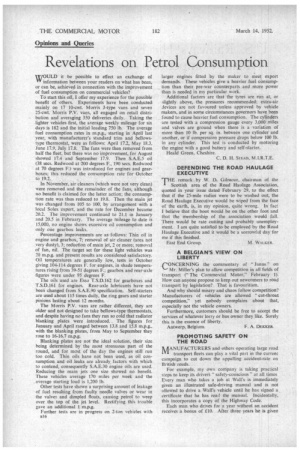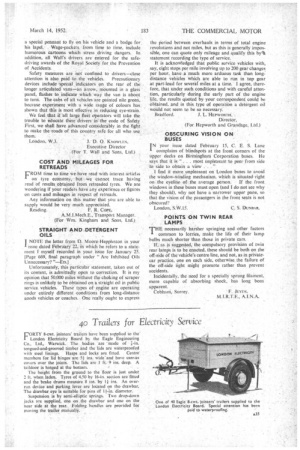Opinions and Queries
Page 50

Page 53

If you've noticed an error in this article please click here to report it so we can fix it.
Revelations on Petrol Consumption
\WOULD it be possible to effect an exchange of vv information between your readers on what has been, or can be, achieved in connection with the improvement of fuel consumption on commercial vehicles?
To start this off, I offer my experience for the possible benefit of others. Experiments have been conducted mainly on 17 10-cwt. Morris 1-type vans and seven 25-cwt. Morris P.V. vans, all engaged on retail distribution and averaging 350 deliveries daily. Taking the lighter vehicles first, the average weekly mileage for six days is 182 and the initial loading 750 lb. The average fuel consumption rates in m.p.g., starting in April last year, with manufacturer's standard trim and bellowstype thermostat, were as follows: April 17.2, May 18.3, June 17.9, July 17.8. The fans were then removed from half the fleet, but there was no improvement, for August showed 17.4 and September 17.9. Then S.A.E.S oil (38 sees. Redwood at 200 degrees F., 190 secs. Redwood at 70 degrees F.) was introduced for engines and gearboxes; this reduced the consumption rate for October to 19.2.
In November, air cleaners (which were not very clean) were removed and the remainder of the fans, although no benefit is claimed for the latter action; the consumption rate was thus reduced to 19.8. Then the main jet was changed from 105 to 100, by arrangement with a local Solex expert, and the rate for December became 20.2. The improvement continued to 21.1 in January and 20.5 in February. The average mileage to date is 15,000, no engine shows excessive oil consumption and only one gearbox leaks.
Percentage improvements are as follows: Thin oil in engine and gearbox, 7; removal of air cleaner (area not very dusty), 3; reduction of main jet, 2 or more; removal of fan, nil. The target set for these light vehicles was 20 m.p.g. and present results are considered satisfactory. Oil temperatures are generally low, tests in October giving 104-114 degrees F. for engines, in shade temperatures rising from 39-51 degrees F.; gearbox and rear-axle figures were under 95 degrees F.
The oils used are Esso T.S.D.162 for gearboxes and T.S.D.161 for engines. Rear-axle lubricants have not been changed from S.A.E.% specification. Self-starters are used about 115 times daily, the ring gears and starter pinions lasting about 12 months.
The Morris P.V. vans are rather different, they are older and not designed to take bellows-type thermostats, and despite having no fans they run so cold that radiator blanking plates were introduced. The figures for January and April ranged between 13.8 and 15.8 m.p.g., with the blanking plates, from May to September they rose to 16-16.7 m.p.g.
Blanking plates are not the ideal solution, their size being determined by the most strenuous part of the round, and for most of the day the engines still run too cold. Thin oils have not been used, as oil consumption and oil leaks are already factors with which to contend, consequently S.A.E.30 engine oils are used. Reducing the main jets one size showed no benefit. These vehicles average 170 miles per week and the average starting toad is 1,200 lb.
Other tests have shown a surprising amount of leakage of fuel resulting from faulty needle valves or wear in the valve5 and dimpled floats, causing petrol to weep over the top of the jet level. Rectifying this trouble gave an additional 1 m.p.g.
Further tests are in progress on 2-ton vehicles with n16 larger engines fitted by the maker to meet export demands. These vehicles give a heavier fuel consumption than their pre-war counterparts and more power than is needed in my particular work.
Additional factors are that the tyres are run at, or ;lightly above, the pressures recommended; extra-air devices are not favoured unless approved by vehicle makers, and in some circumstances governors have been found to cause heavier fuel consumption. The cylinders are tested with a compression gauge every 3,000 miles and valves are ground when there is a variation of more than 10 lb. per sq. in. between one cylinder and another, or if compression pressure drops below 100 lb. in any cylinder. This test is conducted by motoring the engine with a good battery and self-starter.
Heald Green, Cheshire.
C. D. H. STEAD, M.1.R.T.E.
DEFENDING THE ROAD HAULAGE EXECUTIVE
THE remark. by W. D. Gilmour, chairman of the
Scottish area of the Road Haulage AsSociation, quoted in your issue dated February 29, to the effect that if the 25-mile radius were to be washed out, the Road Haulage Executive would be wiped from the face of the earth, is, in my opinion, quite wrong. In fact I believe that the boot would be on the other foot and that the membership of the association would fall. There would be rate cutting and probably unemployment. I am quite satisfied to be employed by the Road Haulage Executive and it would be a sorrowful day for me if this finished.
East End Group. M. WALKER.
A BELGIAN'S VIEW ON LIBERTY CONCERNING the commentary of "Janus" on Mr. Miller's plan to allow competition in all fields of transport (" The Commercial Motor," February 1). How can anyone propose to keep out newcomers to road transport by legislation? That is favouritism.
And why should misery and chaos follow competition? Manufacturers of vehicles are allowed "cut-throat competition," yet nobody complains about that, especially not the vehicle owners.
Furthermore, customers should be free to accept the services of whatever lorry or bus owner they like. Surely this is the essence of liberty.
Antwerp, Belgium. F. A. DEKKER.
PROMOTING SAFETY ON THE ROAD
NAANUFACTURERS and others operating large road I" transport fleets can play a vital part in the current campaign to cut down the appalling accident-rate on British roads.
For example, my own company is taking practical steps to keep its drivers "safety-conscious " at all times Every man who takes a job at Wall's is immediately given an illustrated safe-driving manual and is not allowed to drive a Wail's vehicle until he has signed a , certificate that he has read the manual. Incidentally, this incorporates a copy of the.Highway Code.
Each man who drive § for a year without an accident receives a bonus of 00. After three years he is given a special pennant to fly on his vehicle and a badge for his lapel., . Wage-packets, from time to time, include humorous Cartoons which stress driving dangers. In addition, all Wall's drivers are entered for the safedriving awards of the Royal Society for the Prevention of Accidents.
Safety measures are not confined to drivers—close attention is also paid to the vehicles. .Precautionary devices include 'Special indicators on the rear of the longer .articulated vans—an arrow, mounted in a glass panel flashes to indicate which :way the van is about. to turn. The•cabs of all vehicles _arepainted nile green,. because experiment with .a wide range of Colours has shown that this is most effective in .reducing:•eye-strain. . We feel that if all large .fleet lepertitors Will take the trouble to educate their drivers inthe code of safety First, we shall have advanced considerably. in the ftit. to make the roads of . this country safe for all who use
them. • .London, W.3.
.11. D. 0. KN.iOWLES, , Executive Director
(For T. Wall and Sons, Ltd.) .
. COST AND MILEAGES FOR RETREADS • FROM time to time.we have read with interest-articli:s on tyre economy,but we cannot, trace having read of results. obtained from retreaded tyres. We are wondering if your readers have any experience or figures on costs and mileages in respect of retreads.
Any information on this matter that you are able to supply would be very much appreciated.
Reading. F. R. COPE,
A.M.I.Mech.E., Transport Manager. (ForWm. Kingliam and Sons, Ltd.).
STRAIGHT AND DETERGENT OILS INOTE the letter from p. Moore-Hepplesioet in your issue dated February 22, in which he refers to a statement 1 myself recorded in your issue for January 25: [Page 669, final paragraph under " Are 'Inhibited Oils Unnecessary? "—ED.] Unfortunately, this Particular statement, taken out of its context, is admittedly open to correction. It is my opinion that 50,000 miles without the choking of 'scraper rings is unlikely to be Obtained on a straight oil in public service. vehicles. These types of _engine are operating tinder entirely different -conditions from tong-distance goods vehicles or coaches. One really Ought to express
the period between overhauls in terms of total engine revolutions and not miles, but as this is generally impossible, one can quote only mileage and qualify this byltt statement recording the type of service.
It is acknowledged that public service vehicles with, say, eight stops per mile involving up to 200 gear changes per hour, have a much more arduous task than long: distance vehicles which are able to run in top gear at part-load for several miles at a time. I agree, therefore, that under such conditions and with careful attention, particularly during the early part of the engine Life, the results quoted by your correspondent could be obtained, and in this type of operation a detergent oil would not seem to be so necessary.
Bradford. J. L. HEPWORTH., •
Director, (For Hepworth and Grandage, Ltd.) OBSCURING VISION ON .BUSES IN your issue dated February 15, C. E. S. Lane complains of blindspots at the front corners of the upper decks on Birmingham Corporation buses. He says that it is. " . . most unpleasant -to peer from side
to side to obtain a view .• " find it more unpleasant on London buses to avoid the window-winding mechanism, which is situated-right on the eyelineof the average person. If the front, windows in these buses must open (and I do not see why they should), why not have a narrower upper pane, so that the vision of the passengers in the front seats is not obscured?
London, S.W.15. C. S. DUNBAR.
POI NTS, TWI N REAR LAMPS THE necessarily harsher springing and other factors common to lorries, make the life of fheir lamp bulbs much shorter than those in private cars.
. If,as is Suggested, the compulsory provision of twin rear lainps is to be enacted, these should be both on the off-side of the vehicle's centre line, and not, as.in privatecar practice, one on each side, otherwise, the failure of the off-side light might promote rather than prevent accidents.
Incidentally, the need for a specially sprung filament, more capable of absorbing shock, has long been apparent.
Cobham, Surrey. • F. JEYPS,
A.I.N.A.




















































































